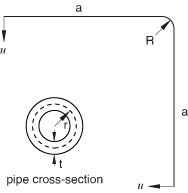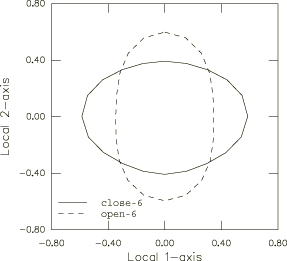Geometry and model
The pipeline configuration used in the study is shown in Figure 1. It is a simple model with two straight pipe sections connected by a 90° elbow. The straight pipes are 25.4 cm (10.0 inches) in length, the radius of the curved section is 10.16 cm (4.0 inches), and the outer radius of the pipe section is 1.27 cm (0.5 inches). The wall thickness of the pipe is varied from 0.03175 cm to 0.2032 cm (0.0125 inches to 0.08 inches) in a parametric study, as discussed below. The pipe material is assumed to be isotropic linear elastic with a Young's modulus of 194 GPa (28.1 × 106 psi) and a Poisson's ratio of 0.0. The straight portions of the pipeline are assumed to be long enough so that warping at the ends of the structure is negligible.
Two loading conditions are analyzed. The first case is shown in Figure 1 with unit inward displacements imposed on both ends of the structure. This loading condition has the effect of closing the pipeline in on itself. In the second case the sense of the applied unit displacements is outward, opening the pipeline. Both cases are considered to be large-displacement/small-strain analyses.
A parametric study comparing the results obtained with different element types (shells, elbows, and pipes) over a range of flexibility factors, k, is performed. As defined in Dodge and Moore (1972), the flexibility factor for an elbow is the ratio of the bending flexibility of the elbow segment to that of a straight pipe of the same dimensions, assuming small displacements and an elastic response. When the internal (gauge) pressure is zero, as is assumed in this study, k can be approximated as
where
R is the bend radius of the curved section, r is the mean radius of the pipe, t is the wall thickness of the pipe, and is Poisson's ratio. Changes in the flexibility factor are introduced by varying the wall thickness of the pipe.
The pipeline is modeled with three different element types: S4 shell elements, ELBOW31 elbow elements, and PIPE31 pipe elements. The S4 shell element model consists of a relatively fine mesh of 40 elements about the circumference and 75 elements along the length. This mesh is deemed fine enough to capture the true response of the pipeline accurately, although no mesh convergence studies are performed. Two analyses are conducted with the shell mesh: one with automatic stabilization using a constant damping factor (see Automatic Stabilization of Static Problems with a Constant Damping Factor), and one with adaptive automatic stabilization (see Adaptive Automatic Stabilization Scheme). The pipe and elbow element meshes consist of 75 elements along the length; the analyses with these element types do not use automatic stabilization.
The results of the shell element model with automatic stabilization using a constant damping factor are taken as the reference solution. The reaction force at the tip of the pipeline is used to evaluate the effectiveness of the pipe and elbow elements. In addition, the ovalization values of the pipeline cross-section predicted by the elbow element models are compared.
The elbow elements are tested with 0, 3, and 6 Fourier modes, respectively. In general, elbow element accuracy improves as more modes are used, although the computational cost increases accordingly. In addition to standard pipe elements, tests are performed on pipe elements with a special flexibility knockdown factor. Flexibility knockdown factors (Dodge and Moore, 1972) are corrections to the bending stiffness based upon linear semianalytical results. They are applied to simple beam elements in an attempt to capture the global effects of ovalization. The knockdown factor is implemented in the PIPE31 elements by scaling the true thickness by the flexibility factor; this is equivalent to scaling the moment of inertia of the pipe element by .





